|
FAQs about Faviid Coral Disease/Health, Pests 5
FAQs on Faviid Disease:
Faviid
Disease 1, Faviid Disease
2, Faviid Disease 3,
Faviid Disease 4,
FAQs on Faviid Disease by Category:
Diagnosing,
Environmental (Pollution/Poisoning, Lighting...),
Nutritional, Social (Allelopathy),
Trauma,
Pathogenic (Infectious, Parasitic, Viral)
Predatory/Pest, Treatments
Related Articles: Coral Pests and Disease; pests, predators,
diseases and conditions by Sara Mavinkurve, Faviid Corals,
FAQs on Stony Coral Disease by Category: Diagnosing,
Environmental (Pollution/Poisoning, Lighting...),
Nutritional, Social (Allelopathy),
Trauma,
Pathogenic (Infectious, Parasitic, Viral)
Predatory/Pest,
Treatments
Faviids 1,
Faviids
2, Faviids 3, Faviid Identification, Faviid Behavior, Faviid Compatibility, Faviid Selection, Faviid Systems, Faviid Feeding, Faviid Reproduction/Propagation,
Stony/True Coral, Coral System Set-Up, Coral System Lighting, Stony Coral Identification, Stony Coral Selection, Coral Placement, Foods/Feeding/Nutrition, Disease/Health, Propagation, Growing Reef Corals, Stony Coral Behavior,
|
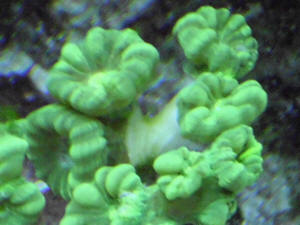
|
|
Trumpet Coral Problem 10/1/15
Dear Wet Web Media,
<Wendy>
I am having a massive loss of yellow trumpet coral and looking
for ideas as to why.
<Will give you the principal sources: predation, environment (ho boy), lack of
nutrition, allelopathy....>
All other fish (6 small), various hermit crabs, snails, starfish, anemones (5
keep splitting)
<Mmm; near by?>
and corals
<See you've listed these below; good>
are acting normally.
165 gallon
4 years old system
Aqua C EV skimmer/LEDs/co2 reactor/refugium/wave maker
SG 1.025, 79-81.5 F temp, Alk 10-12, Calcium 435, magnesium 1340, 0
nitrates, 0 phosphates,
<Ooops! Here's at least part of the "issue"; a lack of N, P, K.... READ here:
http://www.wetwebmedia.com/FavNutrDisF.htm>
20% water changes weekly
<And you dose iodide/ate then?>
The tank has few SPS (birds nest, much monopora), many LPS (frogspawn,
plate, chalice, brain), and 2 large soft corals (toadstool leather and
Sinularia), a couple mushrooms, Ricordeas and some Zoanthids.
<Again; allelopathy is a concern here as well... some of the more chemically
aggressive organisms you have can/do poison other Cnidarians distally at times;
esp. ones that are otherwise compromised (starving in this case)>
No new corals have been added, all have been thriving. I do have a bright yellow
encrusting sponge that I am trying to keep under control.
<This might be a contributor as well>
The trumpet corals have been growing like crazy. I started out with 2 heads
eight years ago and now have 300+ and have traded away 100+.
<Ah, good>
Anyhow, I was gone on vacation (1 week) and think the tank care giver was
feeding too much. (pellets and rinsed frozen food) Upon my return phosphates
were too high, so immediately I did water changes and added PhosBan media to an
extra media reactor I had in my LifeReef sump.
Phosphates were 0 in a few days.
<.... all chemo-photosynthetic life needs measurable soluble HPO4>
Soon after, I lost 2 trumpets (tissue recessed from bottom until dead
in few days). I assumed it was a freak out from phosphate elevated.
<Actually; the opposite>
Well, it's been a month and now the trumpet loss is epidemic, as I have 25% of
the trumpet heads dead or in recession. I have continued to care for the tank as
usual, testing is fine and good water changes. I see no critters on any corals.
What else can I do?
<The I2 mostly; multiple dosed; as you'll find in your reading; removal of the
chemical filtrants...>
I am not even sure the loss is due to a fluctuation in phosphate...?
Should I remove all dead heads and recessing heads or wait it out?
<I'd leave all in place>
Should I do a lugos dip on all trumpets colonies?
<Better to add to the system itself>
What other tests can I do?
<How much time do you have to read?>
Why would only the trumpets (which are spread all over the tank, up and down and
middle) be receding and dying?
<They're on the "losing" side of allelopathogenic "strength" here, and more
susceptible to nutrient deficiency>
Thanks so much! Really, thank you very much for your advice.
Wendy
<Cheers, Bob Fenner>
|
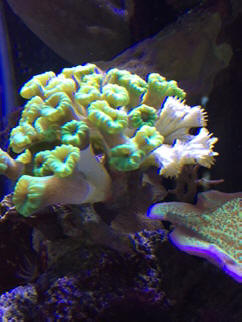 |
|
Re Trumpet Coral Problem, caused by Yellow Encrusting Sponge?
10/6/15
Hi Bob,
<Wend>
Thank you for your opinion on why my trumpet corals are recessing.
Here is some more info:
The anemones are not near the trumpets.
I do add iodide.
I target feed the trumpets and feel they are getting plenty of nutrients or else
they would not be multiplying so fast prior to this mass recession.
(2 to 400 heads in 8 years)
The refugium is full of macro algae and I battle hair algae in the overflows.
Allelopathy could be part of the problem.
My latest thought is in relation to the Jaspis serpentina sponge which is slowly
taking over my tank. A few weeks ago, I was scraping it off the back glass and
trying to dig it away from taking over some Zoanthids and birds nests.
Would the small sponge particles within the water column cause the trumpets to
die off?
<Yes; could>
Would you recommend removing rocks that have this encrusting yellow sponge on
it?
<Yes I would... rinse, chip off; possibly bleach... but at least allow to air
dry for a week or more before re-using>
There is a LOT of yellow sponge in my tank. What does happy yellow sponge
indicate about the tank?
<Propitious circumstances; at least for it. BobF>
Thank you,
Wendy
|
|
Favia Has Blister – 09/25/14
I have a Favia about one year that has been growing nicely. This morning
I noticed an area about 20mm in diameter that has a blister. The soft
tissue has separated from the skeleton. It looks like a boil that
fluctuates in the current from a wave maker.
<<Indeed…and have seen this with my own Favia coral>>
Yesterday I did change my GFO and carbon. Parameters are perfect and I
am growing Acropora with ease in this system. I have attached a photo
showing the coral in question.
<<I see this>>
The lesion is on the right side at about the 1:00 O'clock position. Any
help would be appreciated.
<<As noted, I have experienced this phenomenon in my own system. The
“blister” may be a result of physical trauma (picked at by a
fish/crustacean or stung by another coral)…or maybe it’s even a sign of
a reproductive event (just guessing here). But in my case, it turned out
to be of no worry. I actually ‘popped’ the blister on my Favia coral. It
came back within a week or two…I popped it again, and this time the
coral healed and returned to its normal appearance. Not saying this is
what you should do, but is something to consider. You could also try a
dip in something like Tropic Marin Pro Coral Cure. Aside from this, I
would simply leave the coral be for now and observe>>
Thank you.
Karl
<<Happy to share… EricR>>
|
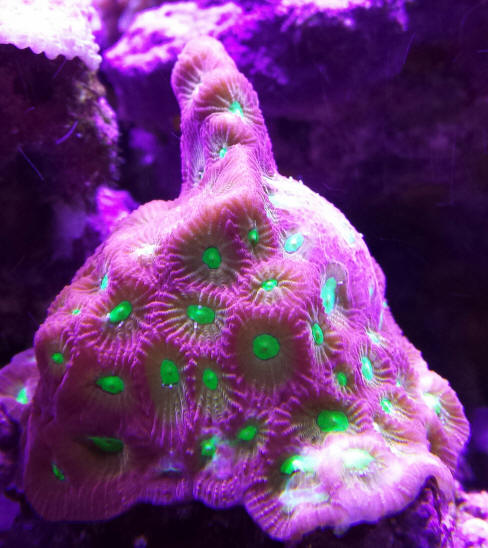 |
|
Re: Favia Has Blister
09/25/14
Thank you Eric for your prompt response!
<<Quite welcome, Karl>>
I cannot remove the coral for dipping as it long ago spread from its
original plug to the rockwork.
<<Okay…should still be fine>>
I do not believe that it was a fish as all my fish are completely reef safe
(That includes any that are considered reef safe "with caution".) I don't
believe it was stung by another coral but I will check tonight to see if any
sweepers come anywhere near it.
<<Then likely these are not the cause of this phenomenon (as was the case
with my own issue re). I’m reluctant to call this a “complaint” as it may
well be a “normal condition” of these animals>>
I will probably pop the "blister" and will keep you informed.
<<Sounds good mate>>
Again, my sincere "thanks".
Karl
<<Always welcome… EricR>>
RE2: Favia Has Blister 10/22/14
Hi Eric,
<<Hey Karl>>
Just a follow up on the Favia as promised.
<<Great!>>
There has been little change. The involved area remains constant. No sloughing.
Sometimes it lies flat on the skeleton and at other times it blows up. Aspirated
two times, will just observe. If there are changes I will advise. Thanks for
your help.
Karl
<<Thanks for the update… You could try excising the loose tissue with a sharp
blade (Exacto/razor)…or if not that bothered, leave as is. Cheers mate…EricR>>
RE3: Favia Has Blister 11/19/14
Hi Eric,
<<Hi Karl>>
In follow up, the area involved has begun to slough exposing coral
skeleton in some areas. Some algae in these areas is noted. I suspect
that the entire blistered area will be lost.
<<Likely so, yes>>
Hopefully, new tissue will grow in from the periphery. Will take many
months.
<<If water quality is maintained and the coral is receiving adequate
light, flow, nutrition, et al…it is very likely to recover, in my
experience/estimation>>
I will inform you of the progress.
Karl
<<Cheers mate…EricR>>
RE4: Favia Has Blister ¬ 10/15/15
Hi Eric,
<<Hey Karl>>
The area has completely healed and filled in. Thanks.
Karl
<<And thank 'you' for the update…Cheers, EricR>>
|
|
Recovering from Sandy - Is my coral dead?
11/11/12
> Hi
> I appreciate you reading my question. I lost power for a week due to
Sandy. My only loss was my fish tank so I am very lucky. I have a 30
gallon reef tank with live rock, two brain corals (Favites or Goniastrea and
a Trachyphyllia geoffroyi), some soft button and leather corals (Zoanthid,
Protopalythoa and Rhodactis) and two Damsel fish. The tank is 8 years
old and I have kept the coral for at least 6 years. Prior to the power
outage, I changed 25% of the water every two weeks and during the weeklong
power outage I periodically tried to circulate the water (with a cup) and I
performed two 2.5 gallon water changes. Despite my efforts, the tank
suffered from lack of filtration, light and warm water. I have
attached two photos: the first taken in 2007 when the coral was very new to
my tank, the second taken today, one week after power was restored to my
house. My questions are simple. Is my brain coral dead?
<Not quite all the way dead>
Should I remove them from the tank
<I would not move>
The fish, button and leather corals all seem to be OK.
> Thank you again. I appreciate your expert advice.
<Keep the faith... as long as there is some attendant tissue, just white
(not algae covered) skeleton, these Stony corals may well come back. Bob
Fenner>
|
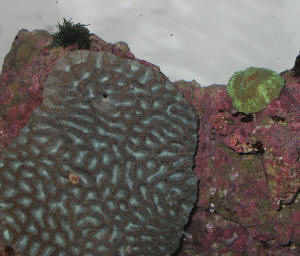
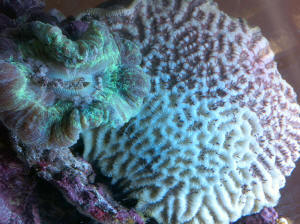 |
Dead Favites Brain 8/17/12 <<RMF>>
Dear WWM,
<Bryce>
I recently ordered a new shipment of corals. Acan Lord, Frogspawn,
Hammer, Goniopora, and Favites Brain. I acclimated them all to my tank,
55 gallon, lit with 4-10k 65watt power compacts. Water parameters:
Ammonia-0, Nitrite-0, Nitrate-5ppm, pH-8.3, KH-10, Calcium-420,
Magnesium-1250, Temp-79-81 depending on light. I placed the Favites on
the substrate in hopes that it wouldn't burn, this was Tuesday.
<Unlikely to burn under PC lighting as Faviids prefer intense light.>
Yesterday, Wednesday, I noticed that my Favites was not looking quite
right. The edges of the skeleton were showing through. I assumed that it
may just be not used to the lighting, because the lights had only come
on about 30 minutes prior to this. Last night, however, the coral still
had not changed, and it didn't respond to my evening feeding. This
morning the Favites was covered with hermit crabs that were picking
loose brown flesh off of the skeleton.
<<Very bad>>
I have never seen a coral decline like this before. My first thought was
possible allelopathy problems,
<<Could well be a contributing cause here>>
however it was more than 12 inches from all the other corals. Toxins
crossed my mind, but no other corals were showing signs, including my
large red Trachyphyllia. The corals in the tank before the shipment
were: Trachyphyllia sp, Caulastrea sp, Tubastrea sp, Galaxea sp,
<<Very strong allelopathogenically>>
and Duncanopsammia axifuga. I have been using carbon, and water changes
to try and minimize the negative reactions. I also had the Galaxea on
the other side of the tank, and about seven inches higher than all the
others because I knew that they have very long sweeper tentacles. I
chose about a year ago not to use a skimmer because I wanted some
residual nutrients in the water column. I also read on a few sites that
Goniopora tend to do well in non-skimmed systems. No other corals are
showing negative behaviors, and I was wondering if this could have just
been damaged in shipping?
<<Also likely>>
Is there something obvious that I overlooked?
<Likely due to stress/handling in shipping. RTN (Rapid
Tissue Necrosis) came to mind but this generally
does not happen with Faviids. I thought of bleaching, but when
this occurs there is no tissue loss as you describe, just an expellation
of Zooxanthellae. I would not discard yet, it's still possible
bleaching may have occurred and the coral may reverse the process. I'll
ask Bob to chime in if he has an idea. James (Salty Dog)>
Bryce
|
Candy cane coral 6/22/12
Hello crew,
So I ordered a shipment of corals off from reefs2go.com and one of them
was a frag of candy cane coral. I saw that there was something in
the head of the coral and panicked because it was killing the coral (I
think) because the skeletal structure was showing were the worm or
something was living.
So naturally I took a knife and cut it out and killed the little pest so
then there is this huge hole in the polyp the rest of the coral looks
fine but these are my first corals so I am wondering... will it recover?
<Yes; should, given good conditions...>
I hope so I am very excited about this coral and I would like to know if
it will recover soon.. here is a picture tell me what your thoughts are
please
Thank you so much
<I'd do a bit of over-dosing w/ iodide-ate... Have you read on WWM re
Caulastrea care? I would. Bob Fenner>
|
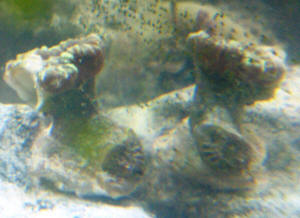 |
Candy Canes, sm. vol., allelopathy
likely 12/16/10
Hi Crew,
<Hello Sam>
I have a 24 gallon AquaPod with a glass top and 96w of T5, 2 actinics
and 2 daylight. Lights on 8 hours full and 2 hours just actinics. I
replace 1 gallon a week and I have a hang-on skimmer. If I see any
algae problems I do more changes. Ammonia, nitrates 0, nitrates .2,
Calcium is about 500,
<too high>
water 1.025 and temp around 80.
<How about pH? Alkalinity? Mg? PO4?>
Crushed coral bottom, snails, a Spotted cardinal, Blue Chromis
<Singular? These are social animals>
, Red Firefish, Clown goby, Neon goby. Candy cane colonies of 25 heads
(brown with blue centers), 12 heads (light blue), 15 heads (light
blue), 6 heads (green), 2 heads (green), Hammer with 10 heads,
Frogspawn of 2 heads and one very large head, Torch with 4 heads and 8
colonies of Acans with about 10 heads each. And one large and beautiful
open brain (Trachyphyllia)about 6 inches across.
<All in a 24g? You have a lot of colonies there>
I feed finely chopped silversides to the corals once a week. I rarely
see any tentacles on the Candycanes so I don't think they get
anything out of it.
<Mmm>
Most of my corals are less than a year old but 3 of the Candycane
colonies are 4 years old if not more. My problem is the green
Candycanes. They just don't last.
My new one of 3 weeks had 5 heads and I am now down to 2. My older one
of almost a year had 8 heads and 2 died in the last two weeks.
A second green colony that I bought at the same time died within the
first couple months. What is different about the green ones that make
it harder for me to keep?
<If all others are doing well then this might be competition between
animals here, with the greens as the 'losers'. Search on WWM
re: allelopathy, you have many corals in a small volume here, a recipe
for problems. An alternative theory is that since different animals
come from different places/ environment/ conditions, and your tank has
a single set of parameters, then these parameters are favourable to
some animals and not others. It is impossible to create a system where
everything you put in will thrive no-matter-what. You might just have
to settle for the fact that you have several animals doing well and be
happy with that. A third theory is water chemistry. There are several
unstated parameters as alluded to above, so I can't comment on
these, but 500 for Ca is too high, I would lower this to about
400ppm.>
Thanks,
<No problem, I hope this has been helpful to you>
Sam
<Simon>
|
Candy Cane Woes?
11/4/10
Hi All-
<Hello Sal>
Been awhile, but I thought I'd let you know what's doing.
I had a little back-n-forth with Scott regarding clowns awhile
ago. I had good success, and the little buggers are 5 months old
(pic attached).
<Well done>
I'm selling them privately. Besides $$ for clowns, I got a
nice candy cane frag as barter from a friend (also, pic
attached). I propped it up on a piece of rubble, but one of my
snails kept knocking it over. So, I pulled it out and wrapped a
rubber band *once *around the "cane" and many times
around the rock. In the process, because my hands were wet and
the coral was covered in mucus, it fell out of my little gloved
hands and onto the floor. Yes, it broke, but fortunately it was a
clean break at the base of a branch. I then
finished my rubber band binding, rinsed it off in fresh seawater,
and replaced the larger piece. I stuck the "base" of
the smaller piece into a hole in a chunk of base rock. Took a day
to "regroup", but it looked fine for 2 weeks.
<Ok, fine so far>
Now, it looks like the green fleshy (polyp?) part is tearing
up.
<Mmm, the file sizes on your pics are far too large for me to
open, so I am replying 'blind' here.. this could be a
polyp bailout, or the coral dying>
It is still opening up and closing, and it is still eating
(target feeding of microgack, yum!) I've never had one of
these before -- is it dying or is it growing?
<Posted>
Water quality is good: pH=8.2, Ca=400, dKH=11.
<Nitrates? Mg? Temp? Salinity?>
I dose 10mL of SeaChem's Reef Plus into a 55g twice a week
(just less than half recommended dose) for trace elements.
<Mmm, not a fan of these products at all>
It's been a very long time since I've had to add
chemicals to maintain ionic balance. I took a look on the site,
but I didn't find anything to answer my question. Could be I
didn't look deep enough?
<Could be'¦ all you can do is keep feeding the coral
and keep the water quality up. It may recover, if bailing out it
may re-grow a new skeleton, or it may not.>
Many thanks,
-Sal
PS - Please let Bob know I've instituted a Catch-And-Release
program for worms -- only the "bad" ones get relocated;
the "good" ones get released back onto the reef ;)
<?? You should never, ever release animals from your home
aquarium back to the reef, you can and will introduce non-native
species that can have devastating consequences on wild animals.
Simon>
<<He's
joshin' ya here Simon. B>>
|
|
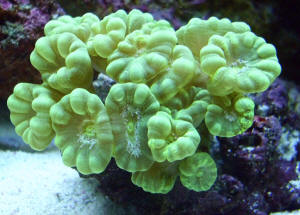
|
Re: Candy Cane Woes? 11/5/10
Hi Simon-
<Hi Sal>
Resending smaller pics. Sorry about that.
<No problem, and well done on the Clowns!>
I want to send another pic of
the two frags so you can see how they're pulling away from the
calcified stalks.
<Mmm, the white strings look like mesenterial filaments to me..a
reaction to something, either chemically or another animal.>
I'll to do that later (at work now), but I did read a few
articles on WWM regarding bailout (including pics) and I'm not
*sure* that's what it is.
<looking at your picture, neither am I>
It does look as though the design of this animal dictates the
polyps must split in order to accommodate a branch.
<Yes, and perhaps that is what you are seeing, but this is not
usually associated with mesenterial filaments>
I have a variety of soft corals, zoos, and mushrooms. <Ahhh! The
likely culprits here.. allelopathy>
All of these are at a good distance and doing fine.
<Yes but sharing the same water system>
I don't test Mg; perhaps I should. <yes> My temp sits at
79-80, and my SG hangs at 1.024.
<Would raise this one notch>
I would like to get them lower, but try as I may I can't get my
NO3 lower than 20ppm.
<For Scleractinians this wants to be less than 10. Are you
testing your source water?>
This tank's been up for 2 years, and since it first cycled it
has never had any NH4, NO2, or PO4.
<Does need a trace of this last>
I use DI only.
<RO?>
BTW, by "Catch-And-Release" I meant releasing worms back
onto the reef in my tank. Bob would be pleased. I'm sorry if my
words led you to believe I meant otherwise.
<Ahh, understood and well done, I like worms in my reef
too!>
Thanks again,
-Sal
<Simon> |
|
Re: Candy Cane Woes? 11/10/10
Hi Simon-
<Hi Sal>
Thanks for the commentary. Allelopathy! Could be -- skimmer's
been working overtime lately, but the snails have been spawning
so it's hard to tell.
Very likely those filaments were a reaction, as that photo was
taken the day after I got the coral (Oct 17).
<Yes>
I took some pics last night as close up as I could. You can see
the filaments retracted. I appreciate how you might consider
another animal, but what? Parasite?
<The toxic softies that you are keeping -- 'mushrooms'
et. Al. These are animals>
They guy (Kenny) who gave it to me says the mother grows like a
weed. You can see what looks like stalk extension in #387 on the
big piece. The "break" is way down at the bottom of
this piece, very close to the stalk. The best shot of the
partitioning is in #388, on the small frag, but you can also see
it on the bigger frag in #389. I've checked the logs, and I
have had a little PO4 trace now and then, but nothing to worry
about.
<ok>
I can move the mushrooms further away (down-current, I presume?)
if you think that will help, but Kenny has a ton of them.
<Different systems and their maintenance/ set up can/ will
have different effects on many things. Can you say that your
system is identical in every way to your friends? Likely not.
Running some carbon might help somewhat here>
I will raise my salinity to 1.025, per your suggestion, and get a
test for Mg. Where should that be, ideally, and what products do
you recommend that work to adjust it?
<Mmm, about three times that of your calcium, something like
1200ppm. How to maintain this depends how large your system is,
it's needs/ wants. Best to research this on WWM, perhaps look
for articles by Randy Holmes Farley on the web. Your coral is
Scleractinian however, and maintenance of Mg is required
here>
Also, in terms of water... I don't do RO -- DI only.
My tap water has NO3 of about 8ppm, and the DI filter removes all
of these.
<Perhaps investing in a true RODI unit might help you
here'¦ will certainly be better than DI only>
As always, much appreciated. Have a great weekend,
<You too Sal, and happy reefing!>
-Sal
<Simon>
|
|

|
|
Re: Candy Cane
Woes? 11/11/10
Hi Simon-
<He's "marked out" for a while>
Oh, boy... where to start?? Yesterday, I discovered my cucumber
got himself sucked up into the filter. FORTUNATELY he didn't
turn out his innards. It could have been worse. Anyway...
Likely, even two "identical" systems will react
differently because Life is unpredictable. I do run carbon all
the time, actually (old school) so I'm ahead of that game. I
don't think it's the mushies, but rather, from the look
of the canes, I think the coral is actually growing. The torn
polyp flesh appears to have reattached itself, and at least one
crown has experienced a division into two distinct polyps.
Apparently, no cause for alarm -- Sal jumped the gun ;)
<Happens>
I am concerned about your suggested Ca level, however. My friend
doesn't keep his anywhere near 1200. He hovers at 500, which
is not far above my level of 400-420.
<Mmm, the 1,200 value doesn't exist. Your stated range is
fine>
He also doesn't do anything with his Mg level.
<Many folks don't... and this is a mistake. Read here:
http://wetwebmedia.com/mgmarfaqs.htm
Like myself, he's no authority, but he does what his son
tells him. His son was the manager of the largest LFS in the
area, and Kenny says he never mentioned Mg.
<Again...>
I went to 3 separate LFS, nobody has an Mg test. I went back to
mine. My LFS guy says they don't stock Mg test kits, but
he'll be happy to order one for me.
<This or the etailers/Net>
The reason he doesn't stock them is, they are very
expensive,
<Not. The Sera, Salifert, other brands are a few tens of
dollars>
nobody buys them, and they expire quickly. Then he asked about my
sudden interest in Mg levels, so I told him about this thread. He
said he doesn't do anything about Mg, either, and keeps his
Ca levels at 600 in his reef tank at home.
<Ludicrous... won't happen w/ adequate KH present. Please
learn to/use the search tool on WWM ahead of writing us. Read
here: http://wetwebmedia.com/calcalkmar.htm
and the linked files above>
He's got a lot of Acros and 2 Candy Canes, all of which grow
like weeds.
I'm going to ask one of the guys at the Lab if he'll run
a water sample through the mass spec for me. Obviously, this is
not something I can do on a regular basis, but it will give me an
accurate reading of all traces, including Mg. I may pick up a
test if I can find one online. While I can't justify it based
on the experience of my peer reef keepers, I do respect your
advice as an expert in this area and want to do the right thing
for my animals.
<See Dr.s Foster & Smith, Marine Depot (.com)... for this
kit>
Thanks much,
-Sal
<Welcome. Bob Fenner>
Re: Candy Cane Woes? 11/11/10
Hi Bob-
<Hey Sal>
Nice to "see" you again. I thank you for the advice. I
think I over-reacted on this one. I went back and read *all* the
emails from Simon -- methinks a misunderstanding happened on my
part and he meant *Mg* should be 1200, not Ca.
<About three times Calcium concentration is right>
This has been the source of my confusion with this thread. Also,
apologies for my typo: My LFS guy keeps his Ca at 500, not
600.
<Still too high IMO>
I am happy report my Mg is at 1247ppm as determined by mass
spectrometer. I also found a Salifert test on Marine Depot which
I'll pick up eventually; thanks for the heads up.
<Welcome>
Regarding the search tool on WWM: I do use it, and very often.
However, in a case where something as specific as this is
concerned, Google doesn't do a good job of returning only
what you want to see.
<Ah yes... do use the search tool that renders the
"cached view"... Much easier to see/find
highlighted/key words>
Be well.
-Sal
<Am trying my friend. BobF>
|
Trumpet/Candy Cane Issues, hlth., data --
09/09/10
Hi,
We have a question about our Trumpet corals and our Candy Canes. The
water parameters are:
Sal 1.024
pH 8.4
NO2 0
NO3 0
<... have to have "some">
NH4 0
Ca 445
Tank 34g
Lights: 2 x 55w pc T5 fluorescent
<Mmm>
Our trumpets were
<When purchased... how long ago?>
a beautiful neon green when purchased from the LFS (almost white). As
soon as they hit our tank, the green became flaky
and they got much darker. I have kept them at the bottom of the tank
since in moderate flow (approx. 24" from lights).
<Likely one issue. Do you access to a PAR meter? Likely there is
insufficient intensity of light... under what regimen were they kept
previously?>
We have been hand feeding
<What foods?>
these guys every other day and while they have grown just a bit, their
color never returned. What is the problem? Should we move them up
closer to the lights? Also I have never seen feeding tentacles come out
on them.
<... can't tell from the information presented>
The second issue (although we are not sure if they are related) is that
our candy canes are doing very poorly. To be honest they never looked
great and we should not have bought them (alot <no such word> of
dead polyps, no growth, no feeders- even after 2 months of coaxing),
but the last time we hand fed them we spotted these very small circular
white worm type things on the top of the heads.
<Likely just part/s of the polyps>
It actually looked like they were going after the brine shrimp we were
placing over the mouths.
When we poked them with a toothpick
<... don't do this>
they tightly retracted. We did a freshwater dip,
<Why?>
and still have seen one worm since then. Now some of the heads have
almost completely bleached and are showing alot of
skeleton. Their coloring has never changed though.
<Might be dyed... artificially>
We do have inverts in the tank as well as other corals that are doing
incredibly well, so we cant figure out what the issue is. These are
also on the sand bed, 24" from the lights and in moderate flow.
Should we move them up as well? Or is this a serious parasite and need
to remove them completely?
Any help is much appreciated,
Thank you!
Courtney & Dan
<... Read here: http://wetwebmedia.com/FaviidDisF4.htm
and the linked files above re the family (Faviidae). Bob Fenner>
|
|

